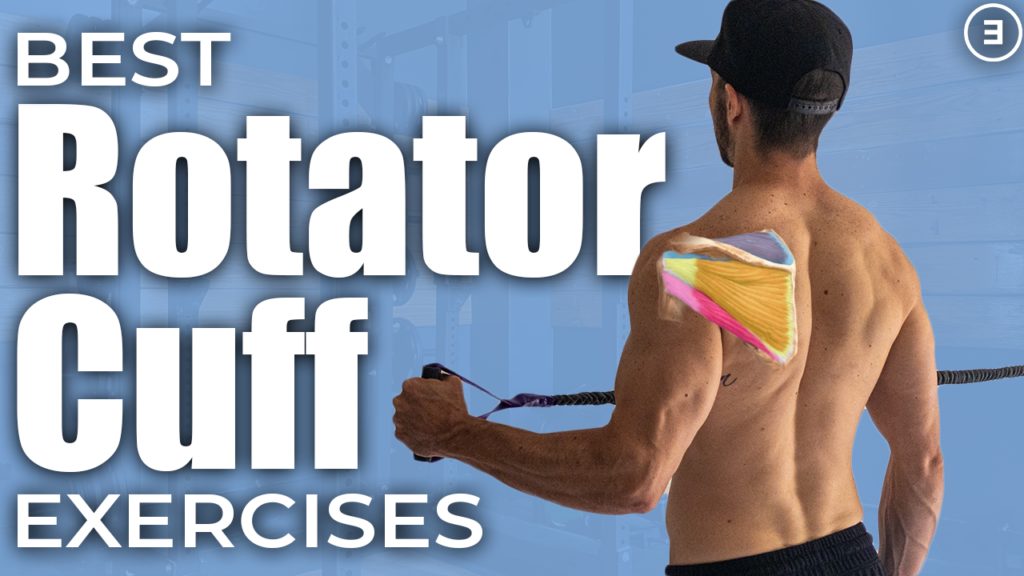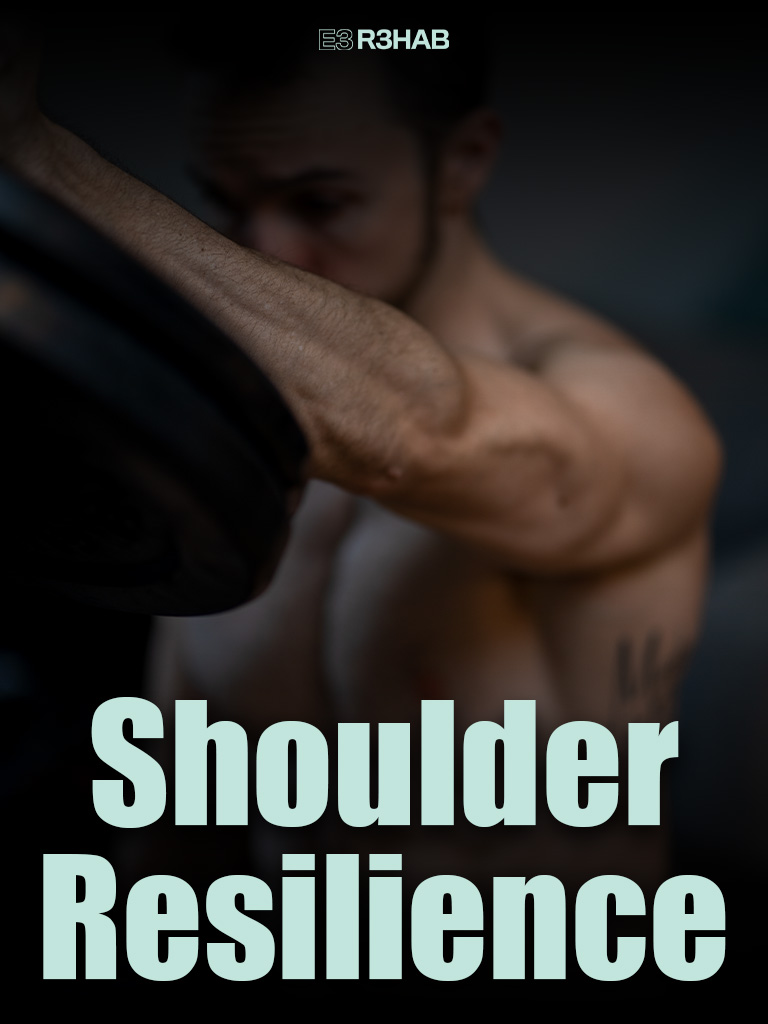The purpose of this blog is to provide an overview of the rotator cuff and its function, and examine what exercises are most effective for activating the rotator cuff based on the scientific evidence.
Looking to improve the strength, range of motion, and control of your shoulders to enhance your function and performance? Check out our Shoulder Resilience program!
Rotator cuff exercises are commonly prescribed in rehab for various pathologies and following surgery, as well as in the fitness community for general shoulder function.
But what exercises are best? Are their ones that are more effective? How many reps and sets should you be doing? And should you be worried about activating other muscles, like the deltoids, during these exercises?
Anatomy and Function
The rotator cuff is in reference to four muscles which originate on our scapula, or shoulder blade, and attach to our humerus, or upper arm. These are the infraspinatus, teres minor, supraspinatus and subscapularis.
Together, they are responsible for protecting and providing dynamic stability to the shoulder joint, while individually, they each have their own role [1].
Infraspinatus and teres minor are primarily responsible for external rotation; the supraspinatus mostly helps control the shoulder joint during abduction, but can also assist in external rotation; and the subscapularis is primarily responsible for internal rotation [1].
While these muscles are commonly associated with rotation based movements, they also show a significant level of activation when performing other shoulder movements, as well (more on that later) [5-9].
Rotator Cuff Exercises

When we think about rotator cuff exercises, some common examples that come to mind are external rotation variations (ie. side lying, standing, and prone), standing arm raises with a weight (ie. empty and full can), and even exercises lying on our stomach (ie. prone Y).
But are some better or more effective than others?
Infraspinatus and Teres Minor
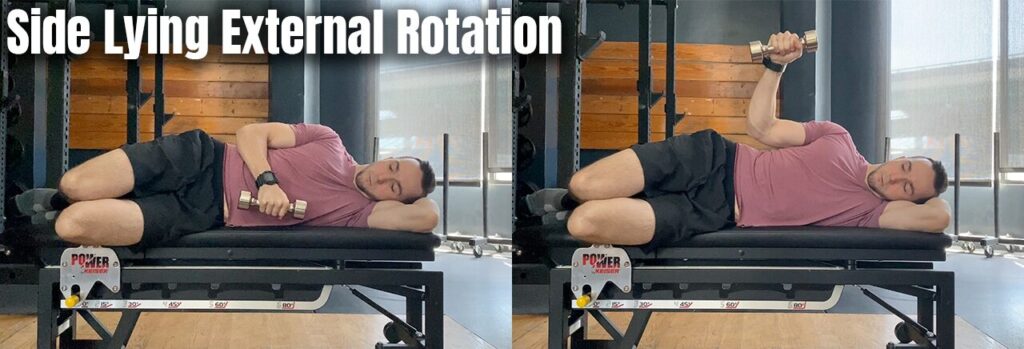
In 2004, Reinold et al. found that infraspinatus and teres minor demonstrated the highest activation during side lying external rotation when compared to other shoulder exercises. This finding makes sense, since as mentioned before, these muscles are primarily responsible for this movement.
One of the other exercises utilized in this study was standing external rotation using a dumbbell. Due to this exercise’s popularity, it is worth discussing briefly. Although this variation does move the arm through external rotation, due to the pull of gravity, there is actually little to no tension on the rotator cuff. Rather, this variation primarily stresses the bicep muscles, so if the goal is to target the rotator cuff, this exercise is really not worth performing.

In a study by Boettcher et al, researchers revealed that infraspinatus activity was similar during the prone Y, prone external rotation and standing banded external rotation exercise. However, comparing these three, the banded external rotation was the one with the least posterior deltoid activation [3].
Supraspinatus
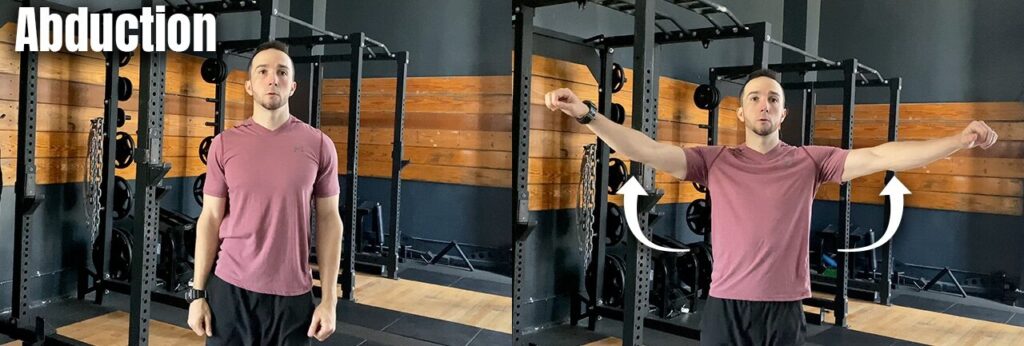
In terms of supraspinatus activation, exercises moving the arm through abduction tend to be utilized more, since this muscle’s primary action is to help control the shoulder joint during this movement.
However, in the previous study just mentioned, when comparing 5 exercises – the empty can, full can, prone Y, prone external rotation and banded external rotation – it was shown that “all exercise positions activated the supraspinatus to equally high levels.” [3].
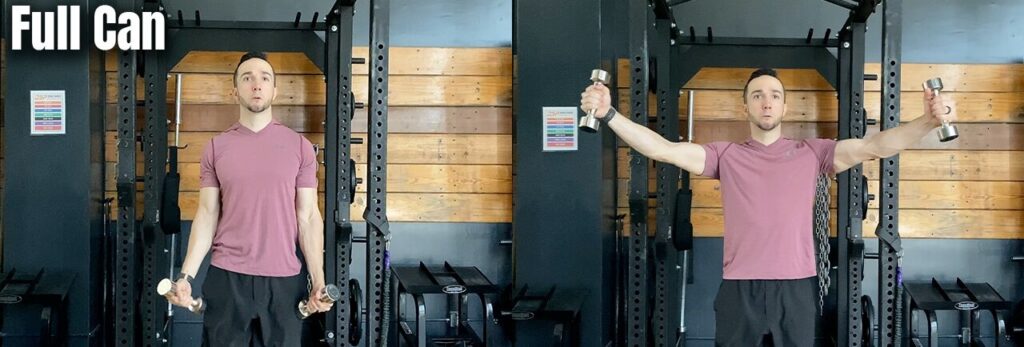
In another study by Reinold et al, they compared supraspinatus activation to deltoid activation during the empty can, full can and prone Y exercise. They found all of these elicited similar supraspinatus activation, but the full can exercise did demonstrate the least posterior and middle deltoid activity of the three [4].
Deltoids
As mentioned previously, there are rotator cuff exercises which will also activate the deltoids to some degree. We can choose an exercise which has a higher or lower rotator cuff to deltoid activation ratio. Exercise selection will depend on individual needs.
There might be occasions where the goal is to elicit more rotator cuff activation and have minimal deltoid contribution. These include cases where the deltoids are already relatively strong- such as a swimmer, baseball player, or someone who may already do a lot of deltoid volume at the gym. Another consideration is an individual whose shoulder is more sensitive to higher loads – such as someone recovering from a shoulder surgery or those experiencing more pain with shoulder exercises.
In these cases, choosing the side lying external rotation or full can exercise might be better options since they have been shown to be more favorable for activating the rotator cuff over the deltoid [2-4].
In contrast, there will also be cases where activating the deltoid will not be a major concern. For these individuals, the goal may simply be to build tissue capacity of the shoulder muscles and increase its tolerance to load.
Therefore, any of the exercises listed previously would be viable options. The main determinants of exercise selection will probably be based on access to equipment and/or comfort levels.
Parameters for Rotator Cuff Exercises
For most of the exercises listed previously, performing 2-4 sets of 10-20 reps close to fatigue, 2-3x/week is a general recommendation. If an individual has specific questions pertaining to their case, it is recommended to seek out a reliable health care practitioner for individualized guidance.
Unconventional Rotator Cuff Exercises

In addition to the exercises mentioned above, it is important to understand the rotator cuff is also active during common strength exercises such as lateral raises, overhead pressing, bench press, rows, and other upper body movements. These not only elicit preferential activation of the rotator cuff, but they move the shoulder through greater range of motion, and help build strength around the scapula, arms, and trunk [5-8].

Lateral raises move the shoulder through abduction and overhead pressing through flexion. With increasing load, these have been shown to demonstrate increased activation of the supraspinatus and infraspinatus, as well as the serratus anterior, lower trap and the deltoids [5-7].
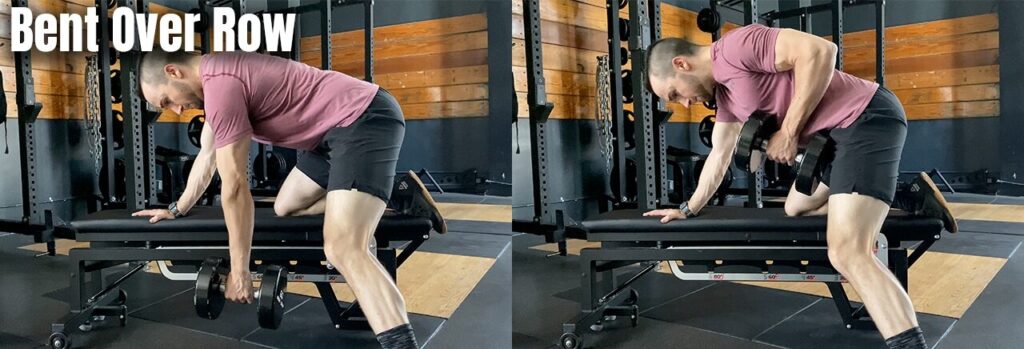
In contrast, rowing and other pulling exercises involving shoulder extension have been shown to have less activation of the posterior rotator cuff (supraspinatus and infraspinatus) compared to subscapularis activation [6,8]. This can be a consideration for populations who may experience discomfort when performing flexion or abduction movements mentioned previously.
Additional Research
EMG studies will have their limitations, so we can pull additional information to support these exercises from others studies which focus on the torque generating capabilities of the shoulder muscles.
In a 2019 systematic review, researchers looked at the maximum moment arms of various shoulder muscles and shoulder movements.
When looking at the table, we see a few key findings:
- The infraspinatus and teres minor have higher moment arm during axial rotation; similar to the side lying external rotation exercise.
- The supraspinatus has a higher moment arm during abduction and flexion, just like the empty can and lateral raise exercises.
- Anterior and middle deltoid moment arms are higher during flexion and abduction, but lowest during axial rotation.
Take Away for Rotator Cuff Exercises
If the goal is to preferentially activate certain rotator cuff muscles with minimal contribution from other muscles, this information can help guide exercise selection.
However, it is worth stressing the importance of larger compound movements like lateral raises and different pressing and pulling variations. While they do elicit activation of other muscles, these exercises should be a strong consideration when designing training or rehabilitation programs which include rotator cuff exercises. These exercises play a significant role in building tissue capacity and load tolerance of the shoulder musculature, as well as help develop an overall more robust system.
Don’t forget to check out our Shoulder Resilience Program!
Want to learn more? Check out some of our other similar blogs:
The Truth About Shoulder Impingement
Thanks for reading. Check out the video and please leave any questions or comments below.
References
- Neumann, Donald A. Kinesiology Of the Musculoskeletal System : Foundations for Physical Rehabilitation. St. Louis :Mosby, 2002.
- Reinold MM, Wilk KE, Fleisig GS, et al. Electromyographic analysis of the rotator cuff and deltoid musculature during common shoulder external rotation exercises. J Orthop Sports Phys Ther. 2004;34(7):385‐394. doi:10.2519/jospt.2004.34.7.385
- Boettcher CE, Ginn KA, Cathers I. Which is the optimal exercise to strengthen supraspinatus?. Med Sci Sports Exerc. 2009;41(11):1979‐1983. doi:10.1249/MSS.0b013e3181a740a7
- Reinold MM, Macrina LC, Wilk KE, et al. Electromyographic analysis of the supraspinatus and deltoid muscles during 3 common rehabilitation exercises. J Athl Train. 2007;42(4):464‐469.
- Reed D, Cathers I, Halaki M, Ginn KA. Does load influence shoulder muscle recruitment patterns during scapular plane abduction?. J Sci Med Sport. 2016;19(9):755‐760. doi:10.1016/j.jsams.2015.10.007
- Wattanaprakornkul D, Cathers I, Halaki M, Ginn KA. The rotator cuff muscles have a direction specific recruitment pattern during shoulder flexion and extension exercises. J Sci Med Sport. 2011;14(5):376‐382. doi:10.1016/j.jsams.2011.01.001
- Wattanaprakornkul D, Halaki M, Boettcher C, Cathers I, Ginn KA. A comprehensive analysis of muscle recruitment patterns during shoulder flexion: an electromyographic study. Clin Anat. 2011;24(5):619‐626. doi:10.1002/ca.21123
- Wattanaprakornkul D, Halaki M, Cathers I, Ginn KA. Direction-specific recruitment of rotator cuff muscles during bench press and row. J Electromyogr Kinesiol. 2011;21(6):1041‐1049. doi:10.1016/j.jelekin.2011.09.002
- Hik F, Ackland DC. The moment arms of the muscles spanning the glenohumeral joint: a systematic review. J Anat. 2019;234(1):1‐15. doi:10.1111/joa.12903


